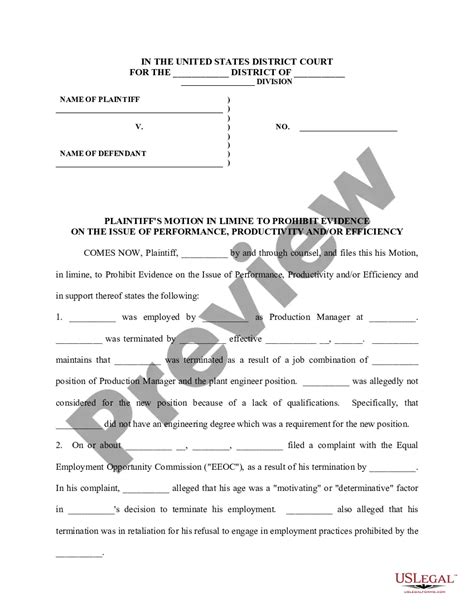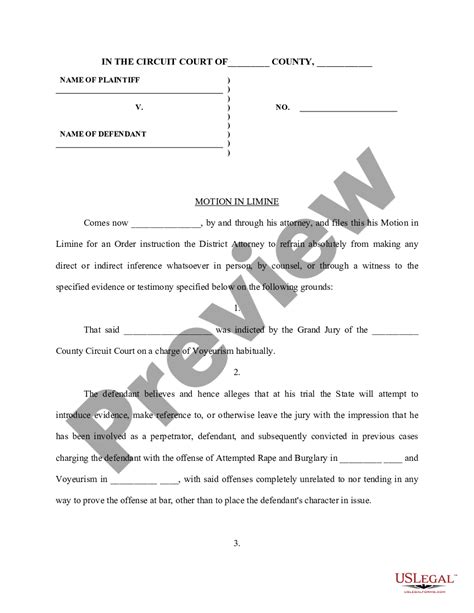Motion in limine is a legal term that refers to a pretrial motion filed by a party in a lawsuit to exclude certain evidence or testimony from being presented at trial. The phrase "in limine" is Latin for "at the threshold," indicating that this motion is made at the beginning of the trial, before the jury is sworn in or evidence is presented. The purpose of a motion in limine is to prevent the introduction of potentially prejudicial, irrelevant, or inadmissible evidence that could influence the jury's decision or compromise the fairness of the trial.
Primary Purpose and Function

The primary purpose of a motion in limine is to allow parties to raise objections to evidence or testimony before the trial begins, thereby avoiding the potential for prejudice or bias that could result from its introduction during the trial. By filing a motion in limine, a party can seek to exclude evidence that is deemed inadmissible under the rules of evidence, such as hearsay, character evidence, or evidence of prior bad acts. This motion can also be used to limit the scope of expert testimony, exclude inflammatory or prejudicial language, or prevent the introduction of evidence that is not relevant to the case at hand.
Types of Motions in Limine
There are several types of motions in limine that can be filed, depending on the specific issue at hand. Some common examples include:
- Motion to exclude hearsay evidence: This type of motion seeks to exclude statements made by someone other than the witness, which are being offered to prove the truth of the matter asserted.
- Motion to exclude character evidence: This type of motion seeks to exclude evidence of a party's character or prior bad acts, which is not relevant to the case at hand.
- Motion to limit expert testimony: This type of motion seeks to limit the scope of expert testimony, or to exclude expert testimony altogether, if it is deemed unreliable or irrelevant.
- Motion to exclude inflammatory or prejudicial language: This type of motion seeks to exclude language or evidence that is deemed inflammatory or prejudicial, and which could potentially bias the jury.
Key Points
- A motion in limine is a pretrial motion used to exclude certain evidence or testimony from being presented at trial.
- The primary purpose of a motion in limine is to prevent the introduction of potentially prejudicial, irrelevant, or inadmissible evidence.
- Motions in limine can be used to exclude hearsay evidence, character evidence, or expert testimony, among other things.
- The motion is typically filed before the trial begins, and is decided by the judge before the jury is sworn in.
- A successful motion in limine can help to ensure a fair trial by preventing the introduction of evidence that could potentially bias the jury.
When deciding a motion in limine, the judge will consider whether the evidence or testimony in question is relevant, reliable, and admissible under the rules of evidence. The judge will also consider whether the evidence or testimony is potentially prejudicial, and whether its introduction could compromise the fairness of the trial. If the motion is granted, the evidence or testimony in question will be excluded from the trial. If the motion is denied, the evidence or testimony will be allowed, and the party may still object to it during the trial.
Procedure for Filing a Motion in Limine

The procedure for filing a motion in limine typically involves the following steps:
- The party seeking to exclude evidence or testimony files a written motion with the court, stating the grounds for the motion and the evidence or testimony to be excluded.
- The opposing party is given an opportunity to respond to the motion, either in writing or at a hearing.
- The judge considers the motion and any responses, and makes a decision on whether to grant or deny the motion.
- If the motion is granted, the evidence or testimony in question will be excluded from the trial.
- If the motion is denied, the evidence or testimony will be allowed, and the party may still object to it during the trial.
| Category | Description |
|---|---|
| Motion in Limine | A pretrial motion to exclude evidence or testimony |
| Purpose | To prevent the introduction of potentially prejudicial, irrelevant, or inadmissible evidence |
| Procedure | File written motion, opposing party responds, judge decides |
| Types | Exclude hearsay, character evidence, expert testimony, inflammatory language |
| Decision | Grant or deny motion, evidence excluded or allowed |

In conclusion, a motion in limine is a crucial pretrial motion that can help to ensure a fair trial by excluding potentially prejudicial, irrelevant, or inadmissible evidence. By understanding the purpose, function, and procedure for filing a motion in limine, parties can better navigate the complexities of the trial process and achieve a more just outcome.
What is the primary purpose of a motion in limine?
+The primary purpose of a motion in limine is to prevent the introduction of potentially prejudicial, irrelevant, or inadmissible evidence that could influence the jury’s decision or compromise the fairness of the trial.
What types of evidence can be excluded through a motion in limine?
+A motion in limine can be used to exclude hearsay evidence, character evidence, expert testimony, and inflammatory or prejudicial language, among other things.
How is a motion in limine decided?
+A motion in limine is decided by the judge, who will consider whether the evidence or testimony in question is relevant, reliable, and admissible under the rules of evidence, and whether its introduction could compromise the fairness of the trial.



